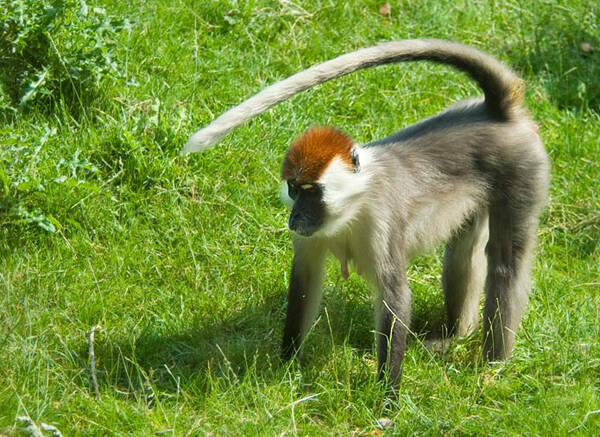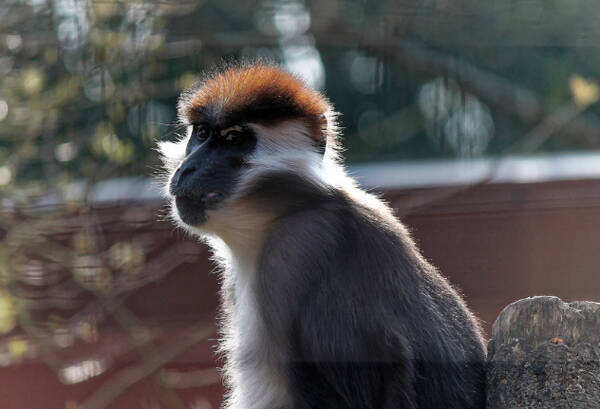Cercocebus torquatus
IUCN
LCBasic Information
Scientific classification
- name:Cercocebus torquatus
- Scientific Name:Cercocebus torquatus,Red-capped Mangabey
- Outline:Primates
- Family:Cercopithecidae Hoolock
Vital signs
- length:45-67cm
- Weight:5-12.5kg
- lifetime:About 20 years
Feature
Chestnut red crest on the head
Distribution and Habitat
Distributed in Cameroon, Equatorial Guinea, Gabon and Nigeria.
The red-capped mangabey inhabits tropical rainforests, primary forests, secondary forests, forest belts and swamp wetlands of the terrestrial biome forests, residing in wet and dry valleys and mangroves. The vertical height of life ranges from sea level to more than 1000 meters.
Appearance
The head and body length of the male red-capped white-browed monkey is 47-67 cm, and the head and body length of the female is 45-60 cm; the tail length is 40-80 cm; the male weighs 7-12.5 kg, and the female weighs 5-8 kg. It is a medium-sized monkey living in Africa, with a chestnut-red crest on the top of the head, hence the name. The fur is slate gray, the lower body is lighter in color, and the hands and feet are slightly darker. There is a white collar on the neck, and the large black ears are very prominent in the white collar. There is a fairly long whisker on the nose and mouth, and the exposed facial skin is black. The upper eyelids are amazingly pure white, which is why some people call it a "four-eyed monkey." The flickering of the eyelids and the combination of various expressions can be clearly seen, and these facial expressions are used for communication.
This large monkey, like other species of the same genus, has a dark gray tail that is longer than its bod
Details
Red-capped Mangabey (scientific name: Cercocebus torquatus), also known as Red-capped Mangabey, has no subspecies and is a medium-sized monkey living in Africa.

Red-capped white-browed monkeys live in multi-male and multi-female family groups, with 12-20 individuals in each group. This social structure leads to their promiscuous breeding system, in which both males and females have multiple mating partners.
Females are more selective in this mixed system, however, females are often victims of male aggression. During estrus, males will mate with multiple females in the same group, and females can also mate with multiple males. Males from outside the group often attack females with infants, and will kill infants and succeed repeatedly. Older and higher-ranking males will defend the females they have mated with and protect their infants. After infanticide, females will immediately enter estrus.
Red-capped white-browed monkeys are diurnal monkeys living on the ground. There is a sexually dimorphic behavior pattern: males are more likely to engage in social behaviors, such as fighting. Although they are mostly active on land, they occasionally live in trees, especially to avoid attacks from predators.
The Red-capped Mangabey has a relatively narrow diet, mainly fruits and nuts, especially palm fruit, but also stems, roots, buds, grains and marsh plants, as well as leaves of grasses, seeds, fungi and fungi. Invertebrates are another staple. They have extremely strong jaws and large incisors to facilitate the consumption of hard food. 25% to 80% of the entire diet varies seasonally, mostly nuts recovered from forest floor litter, and the powerful rear molars can bite through the shells of hard nuts. Occasionally, they eat animal food, such as ground insects and worms, excluding arthropods.

Male red-capped white-browed monkeys have sexual arousal when they are less than 1 year old, but their earliest ejaculation is at the age of 4. Females reach puberty at the age of 4, and reach sexual maturity and reproduction at the age of 5-6. Males mature earlier than females. Females have their first menarche at 30-39 months, when their genitals swell, and usually give birth to their first baby about a year later at 49 to 55 months old. The average interval between births is 13-16 months, and low infant mortality is associated with longer birth intervals. Female red-capped white-browed monkeys give birth to one baby at a time, with a birth rate of 0.92/year.
The breeding season of red-capped white-browed monkeys is from May to September, with an average gestation period of 167 days, the earliest weaning period is 4 months, the average weaning period is 10 months, and the average age of reproductive maturity is 4 years. After the baby is born, it will be carried by the mother on the ventral side, but in the next few months it will cling to its back. The female will carefully feed and care for the baby for 2-7 months, and the lactation period is 4-10 months. The relatives of the baby, there are other brothers and sisters and elders in the tribe aged from 10 to 12 months. If a female loses her young within 6 months, she will immediately enter the estrus period again. Therefore, males will kill these young within 6 months, and infanticide occurs in order to mate with females. After birth, the status of the young in the group ranks second only to the mother, but the male offspring will rise rapidly and rank above the mother after a few years.
The biggest survival crisis facing this species is habitat degradation caused by forest fragmentation, which is caused by human logging and forest loss. There are also local people who hunt for meat. Another major threat is that the species invades agricultural areas, attacks crops or is hunted.
Listed in the 2008 Red List of Endangered Species of the World Conservation Union (IUCN) ver 3.1-Vulnerable (VU).
Protect wild animals and stop eating game.
Maintaining ecological balance is everyone's responsibility!








